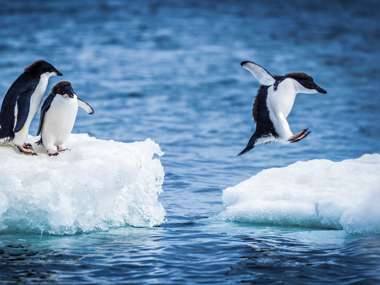Visit Antarctica
The Essence of Antarctica
With its borders battered by the Southern Ocean, and its islands inhabited only by wildlife, the White Continent is a world of its own; an inhospitable wilderness of jaw-dropping landscapes and gigantic icebergs. Its epithet as ‘the continent of superlatives’ is no exaggeration.
Why Should I Go on Tour to Antarctica?
As the world’s southernmost, coldest, most wind-whipped continent, Antarctica’s 5.5million square miles are divided by the Transantarctic Mountains: a 2000 miles-long barrier between the ice-encrusted landmass of the eastern plateau and the smaller, lower, western side, which is essentially a deep sheet of ice covering the mountains of submarine islands.
The continent would form an almost perfect circle around the South Pole, were it not for the Western Peninsula, jutting 600 miles into the seas, pointing at the tip of South America, and making Antarctica pear-shaped.
In this extraordinary environment, no two journeys are ever the same. Ice shelves and glaciers, up to 1800m deep, constantly calve into icebergs and active volcanoes occasionally let off steam. While the continent is all but devoid of life larger than micro-organisms, its islands and surrounding waters are home to magnificent wildlife.
Marking the start of the earth’s ‘Last Continent’, and exposed to the rage of the Southern Ocean, the rugged rocks of the South Shetland Islands are a haven for seabirds from Giant and Storm Petrels to Gentoo and Chinstrap penguins.
Fauna at sea, on the shore and in the sky include Weddell, fur, and leopard seals, orcas in Lemaire Channel, humpback whales among the icebergs of the Gerlache Strait, penguins defending their nests on Cuverville Island, and sightings of the iconic albatross in the Drake Passage.
Expedition vessels sail from Argentinian Ushuaia for a journey that begins in the calms of the Beagle Channel and becomes more dramatic as it crosses the Antarctic Convergence. Here, the cold Antarctic clashes with the warmer Pacific and Atlantic Oceans, passing the wild and desolate Cape Horn, with the lighthouse its only inhabited building. On the rocks, an artwork of the albatross in flight, a maritime symbol of the souls of shipwrecked sailors.
When is the Best Time to go to Antarctica?
The only time for Antarctic journeys is during the summer, from December to March. While the continent is always cold, summers on the peninsula can be surprisingly mild, with temperatures hovering between -2° and 6°. However, the weather is very unpredictable, and can suddenly change to rapid drops in temperature, snowfall, rain, fog, or fierce winds.
Who are Antarctica Tours Best Suited To?
Antarctic exploration is not for the faint-hearted traveller. But, for avid adventurers and wildlife enthusiasts, it is an amazing, enthralling and unforgettable lifetime experience.
The expedition vessel for this route boasts an innovative X-Bow design, giving the stylish ship exceptional stability at sea, and giving you a smoother ride through sometimes rollicking conditions.
Shore visits are by Zodiac landing craft, which may require a general level of fitness and mobility.
Why Book Antarctica Tours with Jules Verne?
With 45 years’ experience and a passion for creating extraordinary adventures, Jules Verne’s journey to the White Continent of Antarctica is aboard an environmentally friendly, purpose-built polar vessel, with a fleet of Zodiac landing craft, and a team of highly knowledgeable expedition guides.
Planned experiences on and around the Antarctic peninsula include a visit to the restored, historic huts at Damoy Point, hiking on the glacier of Neko Harbour, and seeing the huge colonies of penguins on Aitcho and Half Moon Islands. Our Jules Verne guided tours to Antarctica are ABTA and ATOL-protected, and we offer a 100% price guarantee, so you can book with complete confidence.
Expedition Antarctica
An unforgettable 15-day journey taking discerning travellers to distant lands


